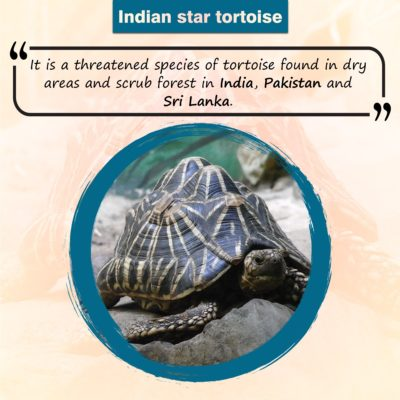Indian Star Tortoise: Conservation Challenges and Biodiversity
Why in the news?
The Indian Star Tortoise faces conservation threats from habitat loss, illegal wildlife trade, and urbanization. Recent findings highlight the species’ genetic diversity and the urgent need for protective measures.
About the Indian Star Tortoise: A Unique Species
- The Indian Star Tortoise is a fascinating species endemic to the Indian subcontinent, known for the star-like patterns on its high-domed shell.
- Recent studies have identified two genetically distinct groups of this species, found in northwestern and southern regions of India, highlighting its biodiversity importance.
Habitat and Distribution:
- These tortoises thrive in semi-arid lowland forests, thorn scrub forests, and arid grasslands, adapting well to environments with wet and dry seasons.
- Their natural range spans arid regions of northwest India, South India, and Sri Lanka. Despite being native to these areas, they are sometimes found as exotic pets in other countries, underlining their global appeal.
Behavior, Diet, and Conservation Status
- Behavior: The Indian Star Tortoise is crepuscular, being most active during the early morning and late afternoon, particularly in hot, dry weather.
- Diet: As herbivores, they feed primarily on grasses, herbaceous plants, and flowers, contributing to local ecosystems.
- Conservation Status: The species is classified as Vulnerable by the IUCN and is protected under CITES Appendix I and Schedule I of India’s Wildlife Protection Act, 1972.
- Threats: Major threats include habitat fragmentation from urbanization and agriculture, alongside illegal wildlife trade for the exotic pet market. These pressures are leading to population declines, making conservation efforts vital.
Key Facts about Indian Star Tortoise (Geochelone elegans):
- Features: Obsidian shell with Sun-yellow star patterns; herbivorous, feeding on grasses, leaves, fruits; diurnal activity pattern.
- Habitat: Arid shrublands, grasslands, and semi-deserts in India, Sri Lanka, and Pakistan.
- Distribution: Northwestern and Southern India; genetically distinct groups.
- Northwestern Group: Genetically stable.
- Southern Group: High genetic diversity, traced to 2 million years ago.
- Threats: Habitat fragmentation, illegal trade (90% linked to exotic pets), and hybridization.
- Conservation: Listed as Vulnerable (IUCN), CITES Appendix I, Wildlife Protection Act Schedule I.
- Genetic Study: Mitochondrial genes (Cytochrome B, NADH Dehydrogenase 4) reveal evolutionary and genetic diversity.
Efforts to protect the Indian Star Tortoise are essential to preserve its unique characteristics and role in local ecosystems, ensuring its survival for future generations.
Sources Referred:
PIB, The Hindu, Indian Express, Hindustan Times




